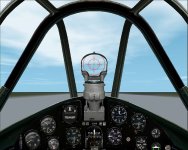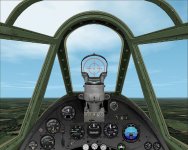Coming from you, the author of two of the best third-party tutorials ever written for CFS2 applications,
this is one heck of a praise!
Thank you very much, sir!

Peperez has recently announced his soon-to-be released Francesco Giuli's FS9 Savoia-Marchetti S.M. 82 Canguro conversion for CFS2. An ongoing team effort that's been carried out since last April-May.
Manuele Villa (MVGrd) and I were called in to provide an historical 2d/VC panel for this conversion. Manuele turned to me the task of "Italianizing" existing gauges, a project I had started last year, when I tackled the conversion of Manuele's FS9 M.C. 205 Veltro. He took care of all the graphic work, I did some touchups too, improving some gauges already converted by Bertrand Pillot (BeePee).
In all truth, it would have been better designing new ones, but neither of us has the necessary C programming skills to create new gauges for CFS2, while doing it for FS9 I am told it's easier, as C programming isn't necessary.
As I wrote in the intro, some of these gauges
do not work exactly as their real life counterparts, because the ones I used had to be metric first of all and secondly, very important,
had to give precise readings.
Manuele and I think along the very same guidelines, where computer flight simulation is a damn' serious affair and absolutely not a 'point-shoot-and-kill' arcade game. I said several times I learned to fly real airplanes with MS' Flight Sims. Although I am not a licensed pilot, I sat at the controls or real small planes and ultra-lights several times, earning praises from their owners and an instructor.
Therefore, I think that an instrument must tell exactly at what speed, altitude, vertical speed, attitude, whatever I need to fly on the pc as if I were in a real cockpit. An imprecise ASI can screw up all landing approaches, on a runway or on a flattop. Or impair controls over a fully loaded aircraft.
I tested every single gauge in flight very carefully, before giving the green light to it. The fact they had to be metric also restricted my options greatly. Obviously, 95% of them come from Luftwaffe gauges, I used a couple that were created for Russian airplanes. The Sperry-Salmoiraghi attitude gauge, whose original manual cover picture I used as a thumbnail for this upload, comes from the CFS1 Hurricane set.
The available Japanese gauges, although metric, work so differently than Italian instruments that were impossible to use.
For example, all of Italian WWII ASI gauges have the 0 kmh speed set in the upper left quadrant of the gauge dial. None of the available Luftwaffe dials start from there. In fact the only two ASIs I was able to produce, the 450 kmh and the 700 kmh, are Luftwaffe gauges with their bitmap replaced by an Italian original Salmoiraghi dial. Although the numeric characters are Italian, they are not placed in the same spot as the originals.
Pepe's S.M.82 conversion will contain all of the gauges described in my manual, but I am seriously thinking to upload the gauge library separately, in order to help people locating it more directly.
What do you think about it?
Cheers!
KH










 I shall correct the manual and ask Rami to replace it in the library.
I shall correct the manual and ask Rami to replace it in the library.




